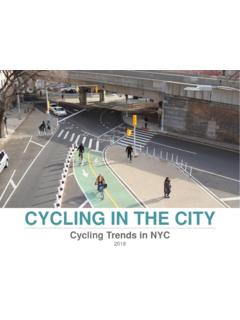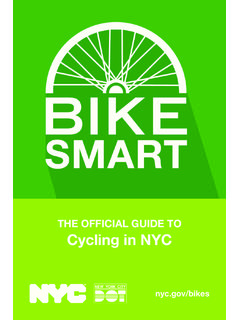Transcription of Current and Future Land Use Models - …
1 Current and Future land Use ModelsMichael WegenerInstitute of Spatial PlanningUniversity of Dortmund, GermanyThe urgency of the environmental debate has renewed the interest in the application of inte-grated Models of urban land use and transportation. In the United States new legislation inspiredby growing environmental awareness such as the Intermodal Surface Transportation Efficiency Actof 1991 requires that transportation planning must consider the interaction between transportationand land use in a consistent fashion as it can be done only by land -use transportation , this new interest in land use Models also presents new challenges to the land usemodelling community.
2 A new generation of activity-based travel Models and new neighborhood-scale transportation planning policies require more detailed information on household demo-graphics and employment characteristics and the location of activities. Moreover, the Models needto be able to predict not only economic but also environmental impacts of land -use transportationpolicies. Today there exist several operational urban land -use transportation Models which havethe potential to respond to these challenges. At the same time there exist exciting opportunities toincorporate new theoretical developments and methodologies into the paper reviews the Current state of the art of operational land -use transportation modelsusing criteria such as comprehensiveness, overall structure, theoretical foundations, modelingtechniques, dynamics, data requirements, calibration and validation.
3 Operationality and applica-bility and evaluates their suitability with respect to the new requirements and speculates about themost promising avenues to further improvement and diffusion of this kind of idea that computer Models of urban land use and transportation might contribute to morerational urban planning was born in the 1950s and culminated in the 1960s. The 'new tools forplanning' (Harris 1965) were thought to be a major technological breakthrough that would revolu-tionize the practice of urban policy making. However, the diffusion of urban Models faltered soonafter the pioneering phase, for a variety of reasons (see Batty 1994; Harris 1994).
4 The most funda-mental probably was that these Models were linked to the rational planning paradigm dominant inmost Western countries at that time. They were perhaps the most ambitious expression of the desireto 'understand' as thoroughly as possible the intricate mechanisms of urban development, and byvirtue of this understanding to forecast and control the Future of cities (Lee 1973). Since then theattitude towards planning has departed from the ideal of synoptic rationalism and turned to a moremodest, incrementalist interpretation of planning; that has at least co-determined the failure ofmany ambitious large-scale modeling presented at the land Use model Conference organized by the Texas Transportation Insti-tute, Dallas, 19-21 February , today the urgency of the environmental debate has renewed the interest in integratedmodels of urban land use and transport.
5 There is growing consensus that the negative environ-mental impacts of transportation cannot be reduced by transportation policies alone but that theyhave to be complemented by measures to reduce the need for mobility by promoting higher-density,mixed-use urban forms more suitable for public transport. In the United States new legislation in-spired by growing environmental awareness such as the Intermodal Surface Transportation Effi-ciency Act of 1991 requires that transportation planning must consider the interaction betweentransportation and land use in a consistent fashion as it can be done only by land -use transporta-tion , this new interest in land use Models also presents new challenges to the land usemodelling community.
6 A new generation of travel Models such as activity-based travel demandmodels require more detailed information on household demographics and employment character-istics, and new neighborhood-scale transportation planning policies to promote the use of publictransport, walking and cycling require more detailed information on the precise location of activi-ties. In addition, the Models need to be able to predict not only economic but also environmentalimpacts of land -use transportation policies, and this requires small area forecasts of emissions fromstationary and mobile sources as well as of immissions in terms of affected there exist several operational urban land -use transportation Models which have thepotential to respond to these challenges.
7 There is a small but tightly knit network of urban modelersdispersed across four continents. There are a dozen or so operational urban/regional Models ofvarying degrees of comprehensiveness and sophistication that have been and are being applied toreal-life metropolitan regions for purposes of research and/or policy analysis. Rapid advances ininformation and computing technology have removed technical barriers besetting earlier genera-tions of land -use transportation Models . At the same time there exist exciting opportunities to in-corporate new theoretical developments and methodologies into the paper reviews the Current state of the art of operational land -use transportation modelsusing criteria such as comprehensiveness, overall structure, theoretical foundations, modeling tech-niques, dynamics, data requirements, calibration and validation.
8 Operationality and applicability andevaluates their suitability with respect to the new requirements and speculates about the mostpromising avenues to further improvement and diffusion of this kind of Map of Urban ModelingBefore proceeding, it is necessary to define the type of model considered in this paper. Thefirst distinction is that the term model is used here to indicate mathematical Models implemented ona computer and designed to analyze and forecast the development of urban or regional land usesystems.
9 The second distinction is that the Models must be comprehensive, they must integratethe most essential processes of spatial development; this implies that they must include at least ur-ban land use, where land use denotes a range of land uses such as residential, industrial and com-mercial. This excludes partial Models addressing only one subsystem such as housing or retail. It isessential that the links from transport to land use is considered in the Models ; transportation itselfmay be modelled either endogenously or by an exogenous transportation model .
10 The Models mustbe operational in the sense that they have been implemented, calibrated and used for policy analy-sis for at least one metropolitan number of real-world applications of Models falling under the above definition has in-creased steadily over the last decade. There are more than twenty university laboratories, publicagencies or private firms on four continents where research and development in urban and regionalmodeling is actively being conducted, and there are a dozen or so operational urban/regional mod-els of varying comprehensiveness and sophistication that have been or are being applied to real-lifemetropolitan regions for research and/or policy this section the geographical distribution of contemporary urban modeling research all overthe world is presented.




